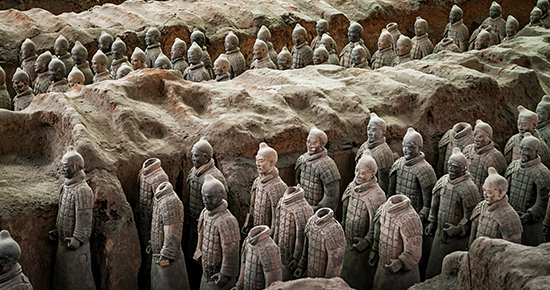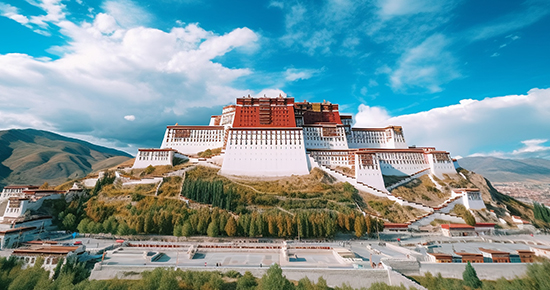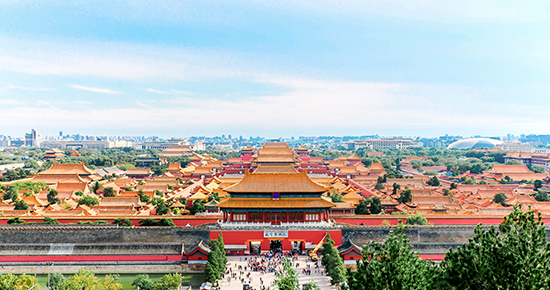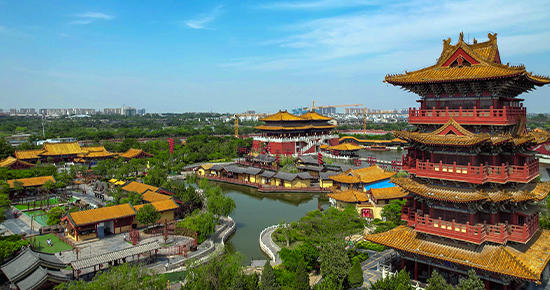Historical Relics
China is an ancient country with a more than five thousand years glorious history; the diligent and intelligent forefathers created brilliant culture and left rich historical relics to the people of these days. With such an unmatched number around the world, China boasts historical relics of various sorts such as ancient sites, historic buildings, ancient tombs, classical gardens, revolution memorial, former residence of the celebrity, intangible heritage and so forth. All of them, both of archaeological value and worth a visit, unfold the long history of Chinese history and culture and witness the great contribution made by Chinese people to the world civilization.
The Terracotta Army and Horses
When visiting such a marvelous place, one should be aware of the great history that is lying behind all the spots and tourist information signs. Indeed, the Terracotta Army and Horses is connected with the early ancient history of China. Everything started in 246 BC when at the age of 13, Emperor Qin Shi Huang, the first Emperor of China ascended to the throne. Most famous Emperor in China's history for he was the one who unified China 2,200 years ago and gave to the country its actual name, Qin Shihuang was responsible for the creation of many of China's outstanding buildings such as the Great Wall, the Summer Palace and here the Terracotta Army and Horses site. Built with the purpose of protecting the tomb of the Emperor and show loyalty to him after his death, the Terracotta Army and Horses site was under construction during 38 years, and around 700 000 workers were needed to complete it. Apart from the terracotta figures, many buried treasures and sacrificial objects, animals and people had accompanied the Emperor in his after life, a real discovery for today's archeologists.

The site of the Army had been discovered accidently in 1974 by a farmer who was digging a well near to its village. Discovering a terracotta head looking like a human face painted in very bright colors, the farmer brought it back home to show his discovery to his family. Curious about what this head was about, they preferred alerting officials about the discovery and finished to bring them to the very place where the farmer had found the head. Soon after did the archeologists and officials realized that the farmer was at the origin of the discovery of one of the world's most important historical site: Emperor Qin Shihuang's Terracotta Army and Horses. Extending the digs, scientists first discovered Pit No.1, the biggest vault out of the three that can be seen today. Since then, the farmer has seen his life completely changed as he is now a celebrity signing autographs and that travelers can meet at the entrance of the Terracotta Army tourist site. Soon after the discovery, the State Council authorized to build a museum on the site and in 1976, two other pits were uncovered at just 20 to 25 meters away from the first pit. Precious site for China's history and humanity as well, the Terracotta Army and Horses has been listed to UNESCO in 1987, one of the greatest discoveries of the 20th century.
The Potala Palace
About 2 kilometers away from the center of Lhasa, the Potala Palace sitting on the Mount Hong (红山) which is believed by the local to be the sacred mountain where Avalokitesvara lives, is an imposing architectural complex originally built in the 7th century before Sontzen Gampo married Princess Bhrikuti of Licchavi Kingdom of Nepal and Princess Wencheng of Tang Dynasty. The whole Potala Palace occupies an area of more than 130,000 square meters. Visitors need to climb 5 slopes if they want to enter the White Palace and the Red Palace of Potala. There are over 1000 rooms in the palace, but only more than 20 of which are opened to tourists at present. Being a palace with political and religionary functions in history, Potala is exquisitely decorated with gorgeous paintings and embossment themed on plateau landscapes, historical legends, Buddhist stories, the scene of building Potala, etc.

Forbidden City
Together with its awe-inspiring architecture comes the impressive historical richness hiding behind the walls of the Forbidden City. During over 5 centuries, the Imperial Forbidden City has been home to 24 Emperors: 14 during the Ming Dynasty (1368–1644) and 10 during the Qing Dynasty (1644–1911). This was in 1406 that the construction of the "Emperor's Palace" started under the request of Emperor Yongle (Ming Dynasty). During 14 years, million of workers and thousands of artisans worked hard in the conception of such a building. The stone used in the construction were the one of the nearby Mount Fang (房山Fang Shan) that were carried pieces after pieces to the city. This is even said that some bricks were made from a combination of white lime and glutinous rice!

As incredible as it can be, these materials ended to be particularly strong for there are still standing today in the capital. Finished in 1420, the Forbidden City started to become the headquarter of China for the capital city of the country moved there from Nanjing. Wartimes, historical events and dynasties' shifts made hard damages to the holly city that was burnt down, rebuilt, sacked and renovated a countless of times. Thus, most of the architecture which can be admired today by tourists traces back to the 1700s onwards. Previously being a site where only emperors were authorized to reside with their imperial family and concubines, the fall of the last emperor of China in 1912 changed the destiny of the city that started to be opened to public and tourists. Recognized by the Chinese central government in 1961 for its important role in China's history, the Forbidden City became progressively a major tourist attraction. The nomination to UNESCO World Cultural Heritage Site in 1987 paid a large tribute to this ancient Chinese and human masterpiece that has succeeded in resisting Dynasties, wars, modern times and tourists' continuous visits.
Mutianyu Great Wall
Oldest section of the whole Great Wall masterpiece, Mutianyu was first built in the mid-6thcentury, during the Northern Qi Dynasty (550-557). The foundation construction of the defensive wall started during the Qi, while the present wall supervision to strengthen its defensive potential was operated by Generals Xu Da, Tan Lun and Qi Jiguang, during the Ming Dynasty (1368-1644) and Emperor Yongle's reign (1402-1424). Mutianyu was built on a strategic pass and served quickly as the northern protective screen guarding the capital. The walls of the section were built using the materials coming from the nearby Qian'an County.

Working everyday for the accomplishment of the Emperor's wish of a material barrier with the outside world, the construction of the Mutianyu Great Wall Gateway was finished to build up in Emperor Longqing's reign (1567-1572). Due to wartimes and the effects of Nature, the wall had to be reconstructed several times such as in 1568 and 1569. Playing its role as a wartime barrier with invaders, the Mutianyu section was a pivotal point on the Great Wall as aliens forces attacked on every sides of the wall. This was only in 1987 that the section was appraised as one of the 16 best scenic spots of Beijing city. Recognized as the World Best of Beijing Tourism in 1992, the Mutianyu Great Wall was then ranked as a 4A grade scenic area in 2002. Mutianyu is since then definitely the largest construction scale of best quality among all sections of the Great Wall.
Qingming Riverside Landscape Garden in Kaifeng
Qingming Riverside Landscape Garden, located in Kaifeng, Henan Province, China, is a large historical and cultural theme park based on the Song Dynasty (960-1279 AD) painting "Along the River During the Qingming Festival". The park meticulously recreates the bustling scenes depicted in the painting, showcasing various aspects of urban life during the Northern Song Dynasty. With elements like rivers, bridges, buildings, and figures, it vividly portrays the prosperous scenery of ancient Bianjing (present-day Kaifeng). Visitors can experience the ancient city's appearance, secular life, and appreciate the unique charm of Song Dynasty culture. Qingming Riverside Landscape Garden is a popular tourist destination that combines history, culture, and art, attracting numerous visitors to experience the allure of ancient Chinese civilization.
